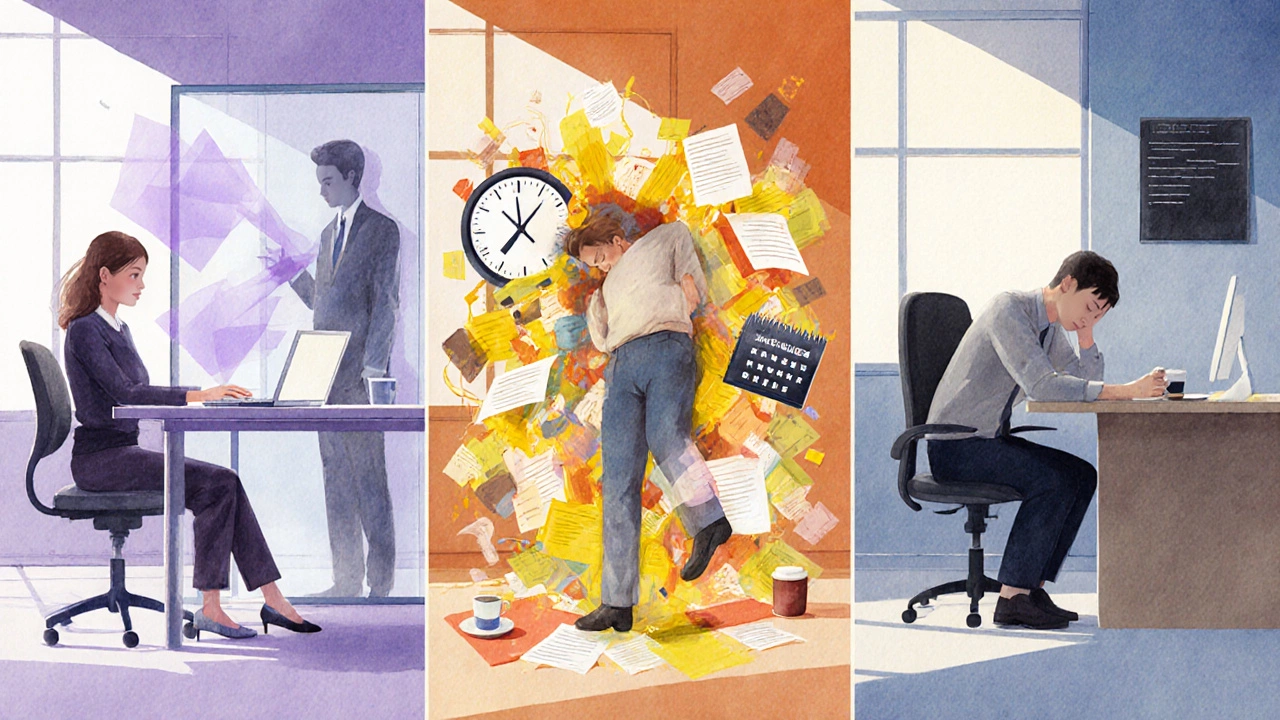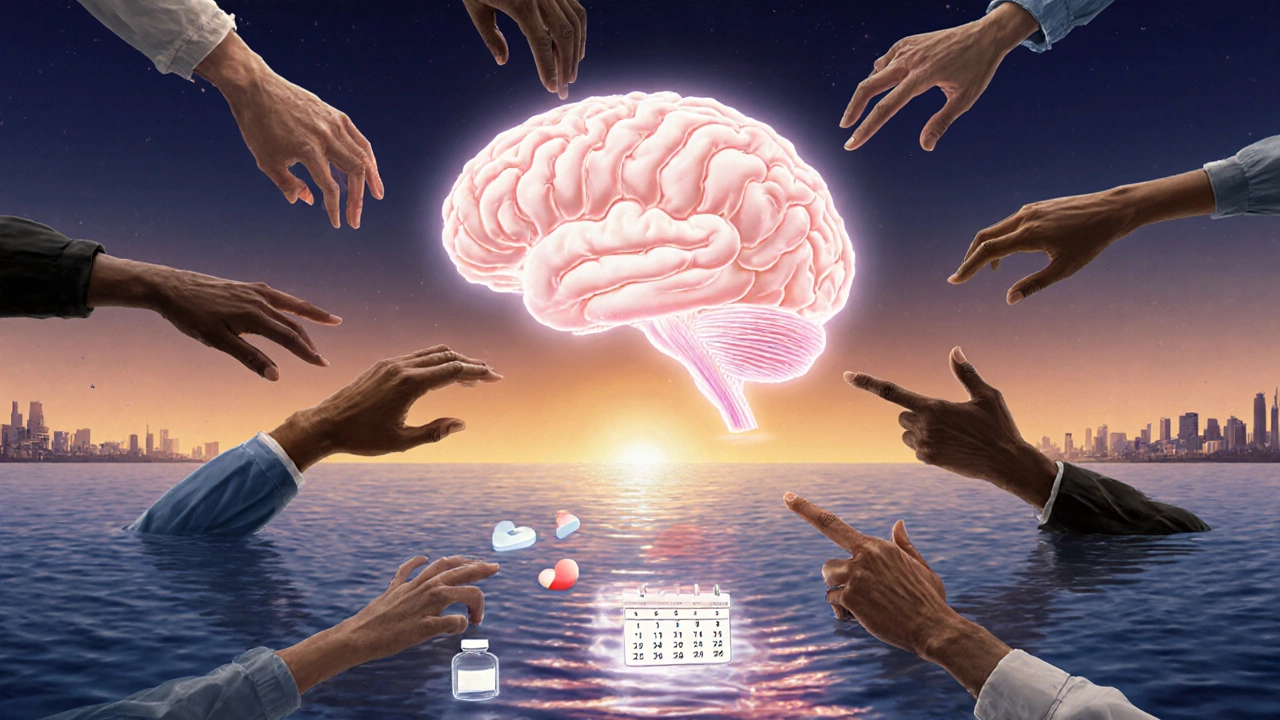Mental Illness Impact Comparator
Select two mental illnesses to compare their impacts and challenges:
Select two disorders and click "Compare Impacts" to see detailed analysis.
Key Factors in Severity
Loss of Reality or Control
Hallucinations in schizophrenia or manic impulsivity in bipolar disorder can make a person feel detached from their own actions.
Emotional Turbulence
Borderline personality disorder produces rapid mood swings that leave both the individual and their supporters exhausted.
Chronic Symptoms
Severe depression can sap motivation every day, while obsessive-compulsive rituals may consume hours of a person's schedule.
Functional Impact
Conditions like schizophrenia and severe depression can severely limit work performance and personal relationships.
Quick Summary
- Schizophrenia, severe depression, and bipolar disorder rank among the toughest conditions because of chronic symptoms and functional impairment.
- Each disorder affects daily life differently-some limit perception of reality, others cause extreme mood swings.
- Early diagnosis, consistent treatment, and strong support networks greatly improve outcomes.
- Understanding warning signs helps friends and family intervene before crises develop.
- Resources such as crisis lines, therapists, and peer groups are vital for long‑term stability.
When people ask, "what is the hardest mental illness to live with?" the answer isn’t a single label. The difficulty varies by symptom severity, treatment response, and how the illness reshapes daily routines. This guide breaks down the most challenging disorders, compares their impact, and offers practical steps for anyone coping or supporting a loved one.
Defining the Landscape
Mental illness is a health condition that affects mood, thinking, or behavior, often disrupting everyday functioning. While many conditions are manageable with therapy and medication, a handful stand out for their relentless grip on perception, emotion, and autonomy.
Which Disorders Are Generally Considered the Hardest?
The following illnesses regularly appear in clinical studies and patient testimonies as the most debilitating:
- Schizophrenia: persistent psychosis, hallucinations, and disordered thought patterns.
- Bipolar disorder (type I): extreme mood swings that alternate between mania and deep depression.
- Major depressive disorder (severe, recurrent): pervasive sadness, loss of interest, and suicidal ideation.
- Borderline personality disorder: intense emotional instability and fear of abandonment.
- Obsessive‑compulsive disorder (severe): intrusive thoughts paired with compulsions that dominate time.
- Post‑traumatic stress disorder: chronic flashbacks and hypervigilance after trauma.
Each of these conditions can cripple relationships, work performance, and self‑care. The following table helps visualise key differences.
| Illness | Core Symptoms | Impact on Daily Functioning | Treatment Complexity | Risk of Suicide |
|---|---|---|---|---|
| Schizophrenia | Hallucinations, delusions, disorganized speech | Severe - often requires supported living | High - antipsychotics + psychosocial rehab | Elevated (≈5‑10% lifetime) |
| Bipolar I | Manic highs, depressive lows, risky behavior | Variable - episodes can halt employment | Medium - mood stabilizers + therapy | High during depressive phases |
| Severe Major Depression | Persistent sadness, fatigue, hopelessness | Very high - often unable to maintain routine | Medium - antidepressants + CBT | Very high (≈15‑20% lifetime) |
| Borderline Personality Disorder | Emotional instability, self‑harm, intense relationships | High - frequent crises and hospitalizations | Medium - DBT is gold standard | High (≈10% suicide attempts) |
| Severe OCD | Obsessions, compulsions that dominate time | High - can interfere with work and hygiene | Medium - SSRIs + exposure therapy | Moderate (increased risk due to comorbidity) |
| PTSD | Re‑experiencing trauma, avoidance, hyperarousal | Variable - flashbacks can halt daily tasks | Medium - trauma‑focused therapy, meds | Elevated (especially with comorbid depression) |

Why These Illnesses Feel Especially Hard
Three common threads make certain disorders feel harder than others:
- Loss of reality or control: Hallucinations in schizophrenia or manic impulsivity in bipolar disorder can make a person feel detached from their own actions.
- Constant emotional turbulence: Borderline personality disorder produces rapid mood swings that leave both the individual and their supporters exhausted.
- Chronic, unrelenting symptoms: Severe depression can sap motivation every day, while obsessive‑compulsive rituals may consume hours of a person's schedule.
When these factors stack, the illness doesn’t just appear in a doctor’s office-it invades breakfast, work emails, friendships, and bedtime thoughts.
Living Day‑to‑Day: Real‑World Examples
Consider Maya, a 28‑year‑old graphic designer diagnosed with schizophrenia at 22. She hears voices that comment on her work, making it near impossible to meet deadlines without a quiet, supervised environment. Her employer provided a flexible schedule and a workplace therapist, allowing her to keep her job while attending weekly medication reviews.
Then there’s Jonah, 35, who battles severe bipolar I disorder. During manic episodes he spends entire nights starting new projects, neglecting sleep, and maxing out credit cards. When depression hits, he cannot leave his bed, missing important client meetings. Consistent mood stabilizers and a structured daily routine have helped him navigate the swings, but the unpredictability still feels like walking on a rope.
These snapshots illustrate how the core symptoms shape daily choices, from what to eat to whether to answer a text from a friend.
Practical Steps for Managing the Hardest Conditions
While no single recipe works for everyone, the following strategies have proven useful across the most challenging illnesses:
- Medication adherence: Even when side effects sting, regular dosing reduces relapse risk. Use pill organizers or reminder apps.
- Therapeutic alliances: Cognitive‑behavioral therapy (CBT) for depression, dialectical behavior therapy (DBT) for borderline personality, and trauma‑focused therapy for PTSD all target the specific thought patterns that make life harder.
- Structured daily rhythms: Fixed wake‑up times, meal plans, and scheduled breaks create predictability, calming the brain’s alarm system.
- Peer support: Joining groups like “Schizophrenia Allies” or “Bipolar Support International” offers shared language and practical tips.
- Crisis planning: Keep a list of emergency contacts, warning signs, and a short action plan. Many services offer 24/7 text lines (e.g., Lifeline in NewZealand).

When to Seek Professional Help
If any of the following occur, reach out immediately:
- Thoughts of self‑harm or suicide.
- Sudden increase in hallucinations or delusional intensity.
- Manic behavior that puts safety at risk (e.g., reckless driving, spending sprees).
- Severe anxiety that prevents leaving the house for more than a few hours.
Early intervention can shorten the duration of an episode and protect long‑term functioning.
Resources and Further Reading
Below are reputable organizations and tools that provide reliable information and help lines:
- NewZealand Mental Health Foundation - offers free online guides.
- MindSpot (Australia) - evidence‑based CBT modules accessible worldwide.
- Suicide Prevention Lifeline (NZ) - call 0800111111 or text27777.
- National Alliance on Mental Illness (NAMI) - peer‑led education groups.
- Medication reminder apps such as Medisafe or MyTherapy.
Key Takeaways Revisited
The hardest mental illnesses share three hallmarks: loss of perceived control, relentless symptom cycles, and high functional impact. Schizophrenia, severe bipolar disorder, and major depression often top the list, but each person’s experience is unique. Consistent treatment, structured routines, and robust support networks make the difference between merely surviving and truly thriving.
Frequently Asked Questions
Can someone with schizophrenia lead a normal life?
Yes, with the right mix of medication, therapy, and community support many individuals maintain jobs, relationships, and hobbies. Early diagnosis improves the odds of stable living situations.
What distinguishes severe depression from regular sadness?
Severe depression lasts weeks to months, interferes with basic self‑care, and often includes suicidal thoughts. Ordinary sadness is usually short‑lived and doesn’t cripple daily functioning.
Is bipolar disorder curable?
There is no cure, but most people achieve long‑term stability through mood stabilizers, psychotherapy, and lifestyle management. Consistency is key.
How can family members support someone with borderline personality disorder?
Learning DBT skills, setting clear boundaries, and encouraging professional treatment help. Avoid blaming language and focus on validating emotions while promoting safety.
When is hospitalization necessary for mental illness?
If a person is a danger to themselves or others, cannot care for basic needs, or is experiencing severe psychosis without medication compliance, a short inpatient stay can stabilize the situation.






